英语比较级和最高级
- 格式:doc
- 大小:39.50 KB
- 文档页数:3

1) 规则变化单音节词和少数双音节词,加词尾-er,-est来构成比较级和最高级。
构成法原级比较级最高级一般单音节词tall(高的)taller tallest未尾加-er,-est great(巨大的)greater greatest以不发音的e结尾nice(好的)nicer nicest的单音词和少数large(大的)larger largest以- le结尾的双able(有能力的) abler ablest音节词只加-r,-st以一个辅音字母big(大的)bigger biggest结尾的闭音节单hot热的)hotter hottest音节词,双写结尾的辅音字母,再加-er,-est"以辅音字母+y"easy(容易的)easier easiest结尾的双音节词,busy(忙的)busier busiest改y为i,再加-er,-est少数以-er,-ow clever(聪明的)cleverer cleverest结尾的双音节词narrow(窄的)narrower narrowest未尾加-er,-est其他双音节词和important(重要的)多音节词,在前more important面加more,most most important来构成比较级和easily(容易地)最高级。
more easilymost easily2) 不规则变化原级比较级最高级good(好的)/better bestwell(健康的)bad (坏的)/worse worstill(有病的)old (老的)older/elder oldest/eldestmuch/many(多的)more mostlittle(少的)less leastfar (远的)farther/further farthest/furthest1)在否定句或疑问句中可用so…as。
He cannot run so/as fast as you.2)当as…as 中间有名词时采用以下格式。

英语中的比较级和最高级比较级和最高级是英语中用来对比两个或多个事物在特定品质或性质上的程度的语法结构。
在英语中,比较级和最高级分别用于形容词和副词的比较。
形容词的比较级和最高级比较级形容词的比较级用于比较两个事物在某种特定品质上的程度。
比较级的形式通常在形容词词尾加上 -er,或在前面加上 more。
例如:- old(年长的)→ older(更年长的)- beautiful(美丽的)→ more beautiful(更美丽的)最高级形容词的最高级用于比较三个或更多事物在某种特定品质上的程度,表示最高程度。
最高级的形式通常在形容词词尾加上 -est,或在前面加上 most。
例如:- old(年长的)→ oldest(最年长的)- beautiful(美丽的)→ most beautiful(最美丽的)副词的比较级和最高级比较级副词的比较级用于比较两个动作或状态在某种特定品质上的程度。
比较级的形式通常在副词词尾加上 -er,或在前面加上 more。
例如:- quickly(迅速地)→ more quickly(更迅速地)- slowly(慢慢地)→ slower(更慢慢地)最高级副词的最高级用于比较三个或更多动作或状态在某种特定品质上的程度,表示最高程度。
最高级的形式通常在副词词尾加上-est,或在前面加上 most。
例如:- quickly(迅速地)→ most quickly(最迅速地)- slowly(慢慢地)→ slowest(最慢慢地)以比较级和最高级来表达程度的变化在英语中非常常见,它们可以帮助我们更准确地描述事物之间的差异和特点。
在使用比较级和最高级时,需要注意形容词和副词的不规则变化形式,并且要根据上下文来判断使用哪种形式。
以上是关于英语中比较级和最高级的简要介绍。
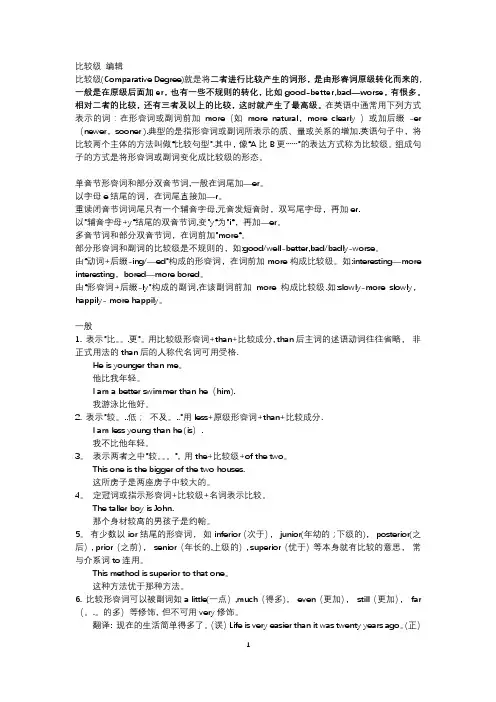
比较级编辑比较级(Comparative Degree)就是将二者进行比较产生的词形,是由形容词原级转化而来的,一般是在原级后面加er,也有一些不规则的转化,比如good-better,bad—worse,有很多。
相对二者的比较,还有三者及以上的比较,这时就产生了最高级。
在英语中通常用下列方式表示的词:在形容词或副词前加more(如more natural,more clearly )或加后缀-er (newer,sooner ).典型的是指形容词或副词所表示的质、量或关系的增加.英语句子中,将比较两个主体的方法叫做“比较句型".其中,像“A比B更……”的表达方式称为比较级。
组成句子的方式是将形容词或副词变化成比较级的形态。
单音节形容词和部分双音节词,一般在词尾加—er。
以字母e结尾的词,在词尾直接加—r。
重读闭音节词词尾只有一个辅音字母,元音发短音时,双写尾字母,再加er.以"辅音字母+y“结尾的双音节词,变"y“为”i“,再加—er。
多音节词和部分双音节词,在词前加”more“。
部分形容词和副词的比较级是不规则的,如:good/well-better,bad/badly-worse。
由“动词+后缀-ing/—ed"构成的形容词,在词前加more构成比较级。
如:interesting—more interesting,bored—more bored。
由“形容词+后缀-ly"构成的副词,在该副词前加more构成比较级.如:slowly-more slowly,happily- more happily。
一般1. 表示”比。
.更"。
用比较级形容词+than+比较成分, than后主词的述语动词往往省略,非正式用法的than后的人称代名词可用受格.He is younger than me。
他比我年轻。
I am a better swimmer than he(him).我游泳比他好。
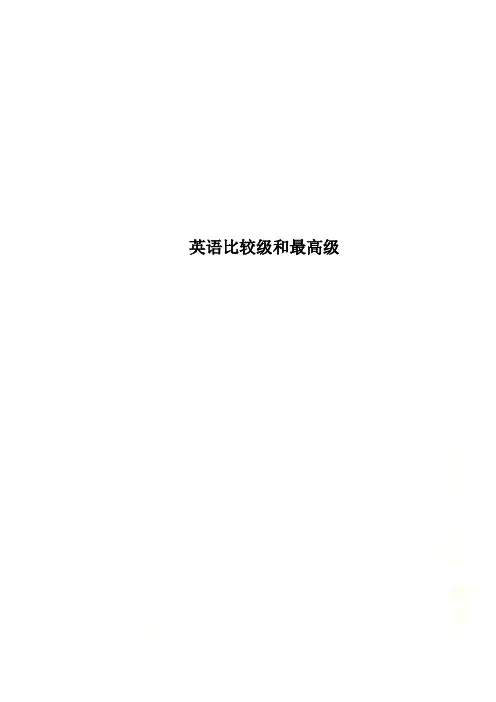
英语比较级和最高级一、比较级和最高级的讲解变化规则1.一般单音节词和少数以-er,-ow结尾的双音节词,比较级在后面加-er,最高级在后面加-est;(1)单音节词如:small→smaller→smallestshort→shorter→shortesttall→taller→tallestgreat→greater→greatest(2)双音节词如:clever→cleverer→cleverestn arrow→narrower→narrowest2.以不发音e结尾的单音节词,比较在原级后加-r,最高级在原级后加-st;如:large→larger→largestnice→nicer→nicest able→abler→ablest3.在重读闭音节(即:辅音+元音+辅音)中,先双写末尾的辅音字母,比较级加-er,最高级加-est;如:big→bigger→biggesthot→hotter→hottest fat→fatter→fattest4.以“辅音字母+y”结尾的双音节词,把y 改为i,比较级加-er,最高级加-est;如:easy→easier→easiestheavy→heavier→heaviestbusy→busier→busiesthappy→happier→happiest5.其他双音节词和多音节词,比较级在前面加more,最高级在前面加most;如:beautiful→more beautiful→most beautifuldifferent→more different→most d ifferenteasily→more easily→most easily注意:(1)形容词最高级前通常必须用定冠词the,副词最高级前可不用。
例句:The Sahara is the biggest desert in the world.(2)形容词most前面没有the,不表示最高级的含义,只表示"非常"。

什么是比较级和最高级?比较级(Comparative)和最高级(Superlative)是英语中用来表达事物之间的比较关系的形式。
它们用于比较名词、形容词和副词的程度或数量。
比较级用于比较两个事物之间的差异,表达一个事物相对于另一个事物的程度更高或更低。
最常见的比较级形式是在形容词和副词前加上"-er"或在前面加上"more"。
例如:1. He is taller than his brother.(他比他的兄弟高。
)2. She speaks more fluently than me.(她比我说得更流利。
)在第一个例子中,我们使用了形容词"tall"的比较级形式"taller"来比较两个人的身高。
在第二个例子中,我们使用了副词"fluently"的比较级形式"more fluently"来比较两个人的口语流利程度。
最高级用于比较三个或三个以上的事物之间的差异,表达一个事物在一组事物中的程度最高或最低。
最常见的最高级形式是在形容词和副词前加上"-est"或在前面加上"most"。
例如:1. She is the tallest girl in her class.(她是班上最高的女孩。
)2. This is the most delicious cake I've ever tasted.(这是我品尝过的最美味的蛋糕。
)在第一个例子中,我们使用了形容词"tall"的最高级形式"tallest"来比较一个女孩和她班上其他女孩的身高。
在第二个例子中,我们使用了形容词"delicious"的最高级形式"most delicious"来比较这个蛋糕和其他蛋糕的美味程度。

一、比较级和最高级的讲解变化规则1.一般单音节词和少数以-er,-ow结尾的双音节词,比较级在后面加-er,最高级在后面加-est;(1)单音节词如:small→smaller→smallestshort→shorter→shortesttall→taller→tallestgreat→greater→greatest(2)双音节词如:clever→cleverer→cleverestnarrow→narrower→narrowest2.以不发音e结尾的单音节词,比较在原级后加-r,最高级在原级后加-st;如:large→larger→largest nice→nicer→nicest able→abler→ablest3.在重读闭音节(即:辅音+元音+辅音)中,先双写末尾的辅音字母,比较级加-er,最高级加-est;如:big→bigger→biggest hot→hotter→hottest fat→fatter→fattest4.以“辅音字母+y”结尾的双音节词,把y改为i,比较级加-er,最高级加-est;如:easy→easier→easiest heavy→heavier→heaviestbusy→busier→busiest happy→happier→happiest5.其他双音节词和多音节词,比较级在前面加more,最高级在前面加most;如:beautiful→more beautiful→most beautifuldifferent→more different→most differenteasily→more easily→most easily注意:(1)形容词最高级前通常必须用定冠词the,副词最高级前可不用。
例句:The Sahara is the biggest desert in the world.(2)形容词most前面没有the,不表示最高级的含义,只表示"非常"。
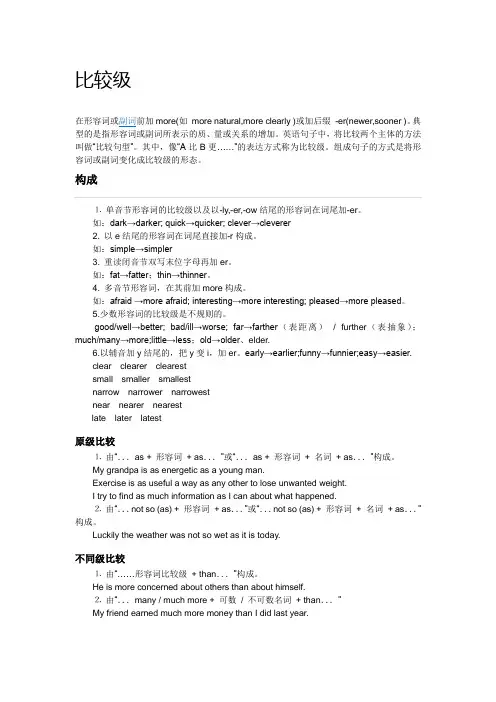
比较级在形容词或副词前加more(如more natural,more clearly )或加后缀-er(newer,sooner )。
典型的是指形容词或副词所表示的质、量或关系的增加。
英语句子中,将比较两个主体的方法叫做“比较句型”。
其中,像“A比B更……”的表达方式称为比较级。
组成句子的方式是将形容词或副词变化成比较级的形态。
构成⒈单音节形容词的比较级以及以-ly,-er,-ow结尾的形容词在词尾加-er。
如:dark→darker; quick→quicker; clever→cleverer2. 以e结尾的形容词在词尾直接加-r构成。
如:simple→simpler3. 重读闭音节双写末位字母再加er。
如:fat→fatter;thin→thinner。
4. 多音节形容词,在其前加more构成。
如:afraid →more afraid; interesting→more interesting; pleased→more pleased。
5.少数形容词的比较级是不规则的。
good/well→better; bad/ill→worse; far→farther(表距离)/ further(表抽象);much/many→more;little→less;old→older、elder.6.以辅音加y结尾的,把y变i,加er。
early→earlier;funny→funnier;easy→easier.clear clearer clearestsmall smaller smallestnarrow narrower narrowestnear nearer nearestlate later latest原级比较⒈由“...as + 形容词+ as...”或“...as + 形容词+ 名词+ as...”构成。
My grandpa is as energetic as a young man.Exercise is as useful a way as any other to lose unwanted weight.I try to find as much information as I can about what happened.⒉由“...not so (as) + 形容词+ as...”或“...not so (as) + 形容词+ 名词+ as...”构成。

(一 )比较级和最高级的构成:1 加-er,-est 构成比较级和最高级。
【1】单音节形容词和副词high-higher-highest hard-harder-hardest 【2】以不发音的 -e 结尾的safe-safer-safest late-later-latest【3】辅音字母要双写的情况:【4】以辅音加 -y 结尾的情况dry-drier-driest merry-merrier-merrist 2 加 more,most 构成比较级和最高级。
【1】多音节的形容词和副词expensive-more expensive-most expensivecarefully-more carefully-most carefully【2】由形容词加 -ly 构成的副词slowly-more slowly-most slowlyhighly-more highly-most highly【3】以-ful,-less,-able,-ous,-ive,-ing 等结尾的双音节形容词useless-more useless-most uselessserious-more serious-most seriuos【4】分词形容词 tired,pleased 及 glad,often,real,right,wrong 等单音节形容词tired-more tired-most tiredglad-more glad-most glad( 3 )形容词、副词的比较级和最高级的不规则构成法。
bad/ill/badly-worse-worstmany/much-more-mostlittle-less-leastfar-farther/further-farthest/furthestold-older/elder-oldest/eldest(二) 比较级和最高级的用法1 比较级的表示法:主语 +be +比较级+than …;主语+谓语+比较级+than …( 1 )不同主语的比较:He is two years younger than I.This machine works better than that one.Li Ming studies harder than Wang Ling.( 2 )同一主语不同方面的比较:She is now happier than she has ever been.The exam was easier than we expected.We have had much more rain this year than last year.( 3 )用于修饰比较级的词: even,(very) much,far,a lot,stillThis book is much thicker than that one.He works even harder than before.( 1 ) 形容词和副词最高级的用法三者或三者以上的比较用最高级。

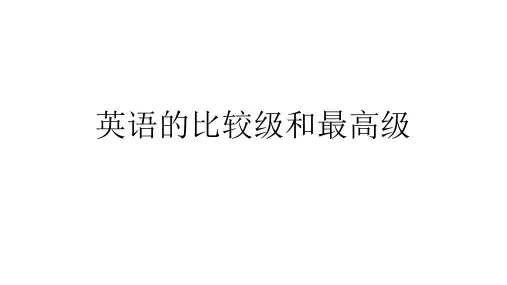
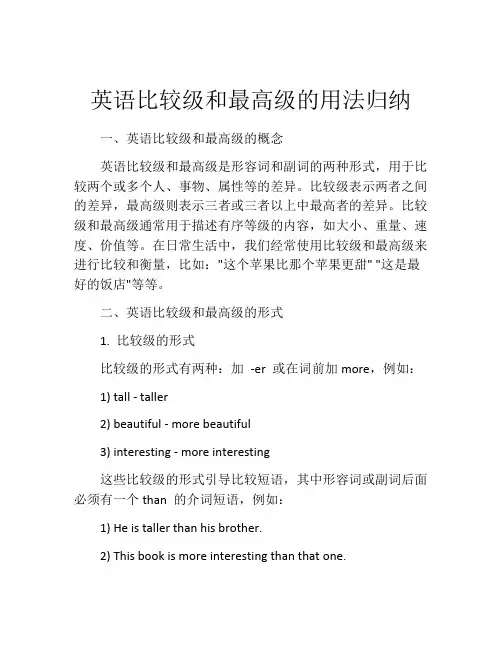
英语比较级和最高级的用法归纳一、英语比较级和最高级的概念英语比较级和最高级是形容词和副词的两种形式,用于比较两个或多个人、事物、属性等的差异。
比较级表示两者之间的差异,最高级则表示三者或三者以上中最高者的差异。
比较级和最高级通常用于描述有序等级的内容,如大小、重量、速度、价值等。
在日常生活中,我们经常使用比较级和最高级来进行比较和衡量,比如:"这个苹果比那个苹果更甜" "这是最好的饭店"等等。
二、英语比较级和最高级的形式1. 比较级的形式比较级的形式有两种:加-er 或在词前加more,例如:1) tall - taller2) beautiful - more beautiful3) interesting - more interesting这些比较级的形式引导比较短语,其中形容词或副词后面必须有一个than 的介词短语,例如:1) He is taller than his brother.2) This book is more interesting than that one.3) The weather is getting colder than yesterday.2. 最高级的形式最高级的形式与比较级的形式相似,但是最高级是加-est 或在词前加most,例如:1) tall - tallest2) beautiful - most beautiful3) interesting - most interesting这些最高级的形式引导最高级短语,其中形容词或副词后面必须有冠词"the" ,或指定的名词,例如:1) He is the tallest boy in his class.2) This is the most interesting book I have ever read.3) The weather is the coldest this winter.三、英语比较级和最高级的用法1. 表示相对高低英语比较级和最高级的最常见用途是表示相对高低。
英语中的比较级和最高级在学习英语的过程中,我们经常会遇到比较级和最高级这两个语法概念。
比较级和最高级是用来比较两个或多个事物之间的差异和优劣的。
掌握比较级和最高级的用法,可以帮助我们更准确地表达自己的意思,丰富我们的语言表达能力。
一、比较级比较级用于比较两个事物之间的差异,表示一个事物相对于另一个事物在某个方面的程度更高或更低。
在构成比较级时,一般在形容词和副词的前面加上“-er”,或在词前加上“more”。
例如,我们可以说:“She is taller than her sister.”(她比她妹妹高。
)在这个句子中,“taller”就是比较级形式,表示“高”的程度比“她妹妹”更高。
除了形容词和副词,一些不规则的形容词和副词也有特殊的比较级形式。
例如,“good”(好)的比较级是“better”(更好),“bad”(坏)的比较级是“worse”(更坏)。
比较级还可以用于表示两个事物之间的相似程度。
例如,“He is as tall as his brother.”(他和他兄弟一样高。
)在这个句子中,“as tall as”表示两者的身高相同。
二、最高级最高级用于比较三个或三个以上的事物,表示其中一个事物在某个方面的程度是最高的。
在构成最高级时,一般在形容词和副词的前面加上“-est”,或在词前加上“most”。
例如,我们可以说:“He is the tallest boy in the class.”(他是班里最高的男孩。
)在这个句子中,“the tallest”就是最高级形式,表示“高”的程度在班级里是最高的。
和比较级一样,一些不规则的形容词和副词也有特殊的最高级形式。
例如,“good”(好)的最高级是“best”(最好),“bad”(坏)的最高级是“worst”(最坏)。
最高级还可以用于表示三个或三个以上事物之间的相似程度。
例如,“He is one of the tallest boys in the class.”(他是班级里最高的男孩之一。
比较级和最高级比较级和最高级是英语中用来比较两个或多个事物程度高低的形式。
它们在句子中起到了非常重要的作用,既可以用于形容词的比较,也可以用于副词的比较。
本文将详细介绍比较级和最高级的用法和形式。
一、形容词比较级和最高级的构成方式1. 形容词比较级的构成方式:比较级由原级加-er构成,如:fast(原级) - faster(比较级)。
2. 形容词最高级的构成方式:最高级由原级加-est构成,如:fast(原级) - fastest(最高级)。
3. 形容词变化规则:- 以一个元音字母结尾的重读闭音节词,双写该词的最后一个字母,再加-er构成比较级,加-est构成最高级,如:big - bigger - biggest。
- 以“辅音字母+y”结尾的词,将y变为i,再加-er构成比较级,加-est构成最高级,如:happy - happier - happiest。
- 以重读闭音节词,末尾只有一个辅音字母时,双写该辅音字母再加-er构成比较级,加-est构成最高级,如:red - redder - reddest。
二、副词比较级和最高级的构成方式1. 副词比较级的构成方式:比较级由原级加-more构成,如:quickly(原级) - more quickly (比较级)。
2. 副词最高级的构成方式:最高级由原级加-most构成,如:quickly(原级) - most quickly (最高级)。
三、使用比较级和最高级的时候需要注意的事项1. 用于比较的两个事物不能相同,否则应使用原级。
2. 特殊的比较级和最高级形式:- good - better - best- bad - worse - worst- many/much - more - most- little - less - least四、比较级和最高级的用法1. 比较级的用法:- 表示两者之间的比较:He is taller than his brother.- 表示否定比较:I am not as tall as my brother.- 表示程度的增减:The weather is getting colder.2. 最高级的用法:- 三者或三者以上进行比较:He is the tallest boy in the class.- 表示某一类事物中程度最高:This is the most delicious cake I have ever tasted.五、常见的比较级和最高级形容词和副词形容词:good - better - bestbad - worse - worstmany - more - mostlittle - less - leastold - older/elder - oldest/eldestfar - farther/further - farthest/furthest副词:well - better - bestbadly - worse - worstmuch - more - mostlittle - less - leastfar - farther/further - farthest/furthest六、总结比较级和最高级是英语中用来比较两个或多个事物的程度高低的形式。
形容词比较级和最高级的形式一、形容词比较级和最高级的构成形容词的比较级和最高级变化形式规则如下构成法原级比较级最高级①一般单音节词末尾加er 和est strong stronger strongest②单音节词如果以e结尾,只加r 和st strange stranger strangest③闭音节单音节词如末尾只有一个辅音字母,须先双写这个辅音字母,再加er和est sadbighot sadderbiggerhotter saddestbiggesthottest④少数以y,er(或ure),ow,ble结尾的双音节词,末尾加er和est(以y结尾的词,如y前是辅音字母,把y变成i,再加er和est,以e结尾的词仍只加r和st) angryCleverNarrowNoble angrierCleverernarrowernobler angriestcleverestnarrowestnoblest⑤其他双音节和多音节词都在前面加单词more和most different moredifferent mostdifferent1) The most high 〔A〕mountain in 〔B〕the world is Mount Everest,which is situated 〔C〕in Nepal and istwenty nine thousand one hundred and fourty one feet high 〔D〕 .2) This house is spaciouser 〔A〕than that 〔B〕white 〔C〕one I bought in Rapid City,South Dakota 〔D〕last year.3) Research in the social 〔A〕sciences often proves difficulter 〔B〕than similar 〔C〕work in the physical 〔D〕sciences.二、形容词比较级或最高级的特殊形式:1. 三个或三个以上音节的形容词只能加more和most只能说more beautiful而不能说beautifuller; 只能说the most beautiful而不能说beautifullest。
一、比较级和最高级的讲解变化规则1.一般单音节词和少数以-er,-ow结尾的双音节词,比较级在后面加-er,最高级在后面加-est;(1)单音节词如:small→smaller→smallestshort→shorter→shortesttall→taller→tallestgreat→greater→greatest(2)双音节词如:clever→cleverer→cleverestnarrow→narrower→narrowest2.以不发音e结尾的单音节词,比较在原级后加-r,最高级在原级后加-st;如:large→larger→largest nice→nicer→nicest able→abler→ablest3.在重读闭音节(即:辅音+元音+辅音)中,先双写末尾的辅音字母,比较级加-er,最高级加-est;如:big→bigger→biggest hot→hotter→hottest fat→fatter→fattest4.以“辅音字母+y”结尾的双音节词,把y改为i,比较级加-er,最高级加-est;如:easy→easier→easiest heavy→heavier→heaviestbusy→busier→busiest happy→happier→happiest5.其他双音节词和多音节词,比较级在前面加more,最高级在前面加most;如:beautiful→more beautiful→most beautifuldifferent→more different→most differenteasily→more easily→most easily注意:(1)形容词最高级前通常必须用定冠词 the,副词最高级前可不用。
例句: The Sahara is the biggest desert in the world.(2)形容词most前面没有the,不表示最高级的含义,只表示"非常"。
little:形容词比较级littler/less/lesser形容词最高级littlest/least副词比较级less副词最高级leastfar:形容词比较级farther/further形容词最高级farthest/furthest副词比较级farther/further副词最高级farthest/furthestwell:形容词比较级better形容词最高级best副词比较级better副词最高级bestill:形容词比较级worse形容词最高级worst副词比较级worse副词最高级worstmany:形容词比较级more形容词最高级mostbad:形容词比较级worse形容词最高级worstgood:形容词比较级better形容词最高级:bestold:形容词比较级:older/elder形容词最高级:oldest/eldestgood:比较级better最高级the besthot:比较级hotter最高级the hottestheavy:比较级heavier最高级the heaviestfine:比较级finer最高级the finestexciting:比较级more exciting最高级the most exciting bad:比较级worse最高级the worstcreative:比较级more creative最高级the most creative boring:比较级more boring最高级the most boringfar:比较级farther/further最高级the farthest/the furthest near:比较级nearer最高级the nearest如有侵权请联系告知删除,感谢你们的配合!。
一、比较级和最高级的讲解
1.一般单音节词和少数以-er,-ow结尾的双音节词,比较级在后面加-er,最高级在后面加-est;
(1)单音节词
如:small→smaller→smallest short→shorter→shortest
tall→taller→tallest great→greater→greatest
(2)双音节词
如:clever→cleverer→cleverest narrow→narrower→narrowes t
2.以不发音e结尾的单音节词,比较在原级后加-r,最高级在原级后加-st;如:large→larger→largest nice→nicer→nicest able→abler→ablest
3.在重读闭音节(即:辅音+元音+辅音)中,先双写末尾的辅音字母,比较级加-er,最高级加-est;
如:big→bigger→biggest hot→hotter→hottest fat→fatter→fattest
4.以“辅音字母+y”结尾的双音节词,把y改为i,比较级加-er,最高级加-est;如:easy→easier→easiest heavy→heavier→heaviest
busy→busier→busiest happy→happier→happiest
5.其他双音节词和多音节词,比较级在前面加more,最高级在前面加most;如:beautiful→more beautiful→most beautiful
different→more different→most different
easily→more easily→most e asily
注意:(1)形容词最高级前通常必须用定冠词the,副词最高级前可不用。
例句:The Sahara is the biggest desert in the world.
(2)形容词most前面没有the,不表示最高级的含义,只表示"非常"。
It is a most important problem.
=It is a very important problem.
6.有少数形容词、副词的比较级和最高级是不规则的,必须熟记。
如:good→better→best well→better→best
bad→worse→worst ill→worse→worst
old→older/elder→oldest/eldest
many/much→more→most little→less→least
far →further/farther→ furthest/farthest
二、形容词、副词的比较级和最高级的用法
1.“A + be +形容词比较级+ than + B” 意思为“A比B更……”。
如:This tree is taller than that one. 这棵树比那棵树高。
注意:
①在含有连词than的比较级中,前后的比较对象必须是同一范畴,即同类事物之间的比较。
②在比较级前面使用much,表示程度程度“强得多”。
如:A watermelon is much bigger than an apple.
③very, quite一般只能修饰原级,不能修饰比较级。
2.“比较级+ and + 比较级”或“more and more +原级”表示“越来越……”
如:It becomes warmer and warmer when spring comes.
春天来了,天气变得越来越暖和了。
It is getting cooler and cooler.
天气越来越凉爽。
The wind became more and more heavily.
风变得越来越大。
Our school is becoming more and more beautiful.
我们的学校变得越来越美丽。
3.在含有or的选择疑问句中,如果有两者供选择,前面的形容词要用比较级形式。
如:Who is taller,Tim or Tom? 谁更高,Tim还是Tom?
4. “the +比较级……, the+比较级”,表示“越……越……”。
The more money you make, the more you spend.
钱你赚得越多,花得越多。
The sooner,the better.
越快越好。
5. 表示倍数的比较级用法:
①. A is …times the size /height/length/wi dth of B.
如:The new building is three times the height of the old one.
这座新楼比那座旧楼高三倍。
(新楼是旧楼的四倍高)
②. A is …times as big /high/long/wide/large as B.
如:Asia is four times as large as Europe.
亚洲是欧洲的四倍大。
(亚洲比欧洲大三倍)
③. A is …times larger /higher/longe r/wider than B.
如:Our school is twice bigger than yours.
我们学校比你们学校大两倍。
6.形容词、副词的最高级形式主要用来表示三者或三者以上人或事物的比较,表示“最……”的意思。
句子中有表示范围的词或短语。
如:of the three, in our class等等。
如:He is the tallest in our class.
他在我们班里是最高的。
7."否定词语+比较级","否定词语+ so… as"结构表示最高级含义。
Nothing is so easy as this.
=Nothing is easier than this.
=This is the easiest thing.
8. 比较级与最高级的转换:
Mike is the most intelligent in his class.
Mike is more intelligent than any other student in his class
7.修饰比较级和最高级的词
1)可修饰比较级的词
①.a bit, a little, rather, much, far, by far, many, a lot, lots, a great deal, any, still, even等。
②. 还可以用表示倍数的词或度量名词作修饰语。
③. 以上词(除by far)外,必须置于比较级形容词或副词的前面。
注意:使用最高级要注意将主语包括在比较范围内。
(错) Tom is the tallest of his three brothers.
(对) Tom is the tallest of the three brothers.
2)下列词可修饰最高级:by far, far, much, mostly, almost。
This hat is nearly / almost the biggest.
注意:
a. very可修饰最高级,但位置与much不同。
This is the very best.
This is much the best.
b. 序数词通常只修饰最高级。
Africa is the second largest continent.
8.要避免重复使用比较级。
(错) He is more cleverer than his brother.
(对) He is more clever than his brother.
(对) He is cleverer than his brother.
9.要避免将主语含在比较对象中。
(错) China is larger that any country in Asia.
(对) China is larger than any other country in Asia.
10.要注意对应句型,遵循前后一致的原则。
The population of Shanghai is larger than that of Beijing.
It is easier to make a plan than to carry it out.
11.要注意冠词的使用,后有名词的时候,前面才有可能有名词。
比较:Which is larger, Canada or Australia?
Which is the larger country, Canada or Australia?
She is taller than her two sisters.
She is the taller of the two sisters.。